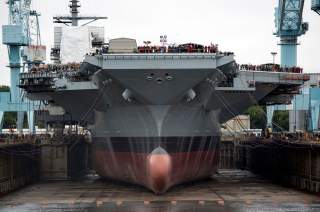America's New Aircraft Carrier Won't Get Any F-35s—Yet
Congress isn't happy.
The Navy decided to omit the gear for the F-35 in order to keep Kennedy under the $11-billion cost cap that Congress has imposed on the ship’s construction. The sailing branch plans to christen Kennedy in late 2019 and add F-35-compatibility at a later date.
The U.S. Navy’s newest aircraft carrier won’t be able to deploy with the service’s newest warplane. At least not at first.
And Congress is unhappy about that, according to Ben Werner at USNI News.
(This first appeared in early June 2019.)
The House Armed Services seapower and projection forces subcommittee included in its version of the 2020 National Defense Authorization Act a ban on the Navy taking delivery of the Ford-class carrier John F. Kennedy unless the carrier can deploy with F-35C Lighting II stealth fighter, Ben Werner reported for USNI News.
The Navy decided to omit the gear for the F-35 in order to keep Kennedy under the $11-billion cost cap that Congress has imposed on the ship’s construction. The sailing branch plans to christen Kennedy in late 2019 and add F-35-compatibility at a later date.
The Navy in February 2019 declared its first F-35C squadron to be combat-ready.
“Cost caps imposed by Congress on the Ford-class program to keep the price of these ships from escalating have accomplished the opposite effect,” a committee staff member told Werner, “with the Navy accepting delivery of unfinished carriers and intending to pay more money later on to add critical capabilities in the future.”.
The jet-compatibility problem is only the latest to afflict the Ford program.
Citing problems with the new supercarrier's nuclear propulsion system and weapons elevators plus minor tweaks testers identified during Ford's post-construction shakedown cruise, James Geurts, the Navy's top acquisitions official, on March 26, 2019 told the U.S. House Armed Services Committee's seapower and projection forces subcommittee that Newport News Shipbuilding in Virginia would deliver Ford in October 2019 rather than in July.
"All three of those causal factors – making the adjustments to the nuclear power plant that we noted during sea trials, fitting in all of the post-shakedown availability workload and finishing up the elevators – they’re all trending about the same time," Geurts told the subcommittee.
"So, October right now is our best estimate. The fleet has been notified of that. They’re working that into their train-up cycle afterward."
The Ford class, in theory, represents a major improvement over the previous Nimitz-class supercarriers. The Navy so has ordered four Fords. Lead vessel Ford is supposed to deploy for the first time in 2022.
The Fords are bigger than the Nimitzs are, boast superior sensors and a more efficient deck layout and feature precise electromagnetic catapults rather than the maintenance-intensive steam catapults that the Nimitzs have.
But the new flattops are expensive. It cost $5 billion just to design the class. Ford cost $13 billion to build. That's roughly as much money at the Navy usually spends on new ships in an entire year.
Problems have vexed the program. The most high-profile failures have involved the Electromagnetic Launch System catapult, a new aircraft arresting system called the Advanced Arresting Gear, the weapons elevators that haul bombs and missiles from the munitions magazines to the deck and the ship’s primary sensor, the Dual Band Radar.
The issues with the propulsion system haven't widely been reported. "The problem isn’t resident in the two nuclear reactors aboard but rather the ship’s main turbines generators that are driven by the steam the reactors produce," USNI News reporter Sam LaGrone explained.
"Sources familiar with the extent of the repairs have told USNI News two of the main turbine generators needed unanticipated and extensive overhauls," LaGrone wrote. "As Geurts told Congress, the ship’s company discovered the problem during sea trials."
David Axe serves as Defense Editor of the National Interest. He is the author of the graphic novels War Fix, War Is Boring and Machete Squad.
Image: Wikimedia

